#beeaware
Text
May 22nd is Bee awareness day and its still mermay. So a quick sketch, first time using a brush pen and it was glorious, finally throwing some colour on. The scanner kills the colours :(




2 notes
·
View notes
Photo
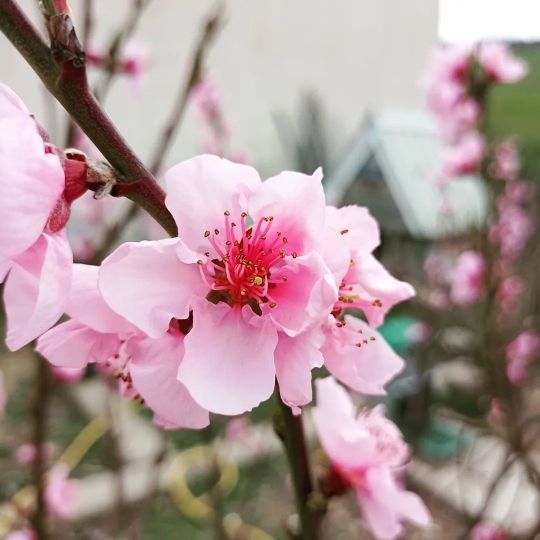
Les floraisons se succèdent en ce moment et aujourd'hui c'est au tour des pêchers de nous offrir leur beauté et leur délicieux parfum ! 🌸🍑 Mais ce n'est pas que pour le plaisir de nos yeux et de notre nez, c'est aussi une aubaine pour nos amies les abeilles qui vont butiner ces fleurs sucrées 🐝💕. Les pêchers sont en effet une source importante de nectar et de pollen pour ces précieuses pollinisatrices 🌸🐝🌸. Alors, prenons quelques instants pour admirer la nature et les petits miracles qui s'y déroulent tous les jours 🌿💚 ► www.mon-abeille.fr #abeilles #rucher #apiculture #nature #environnement #conservation #miellocal #biodiversité #pollinisation #sécuritéalimentaire #merveillesdelanature #pollinisateurs #jardinage #fleurs #écologie #RespectDeLaNature #ProtectionDesAbeilles #SauvonsLesAbeilles #AgricultureDurable #AbeilleDomestique #SustainableFarming #Cleanliness #BeesofInstagram #BeeLovers #BeeAware #BeeFriendly #floraison #naturelover #peachblossom #abeillesheureuses (à Rucher du Pillier) https://www.instagram.com/p/Cp95XJnI9PH/?igshid=NGJjMDIxMWI=
#abeilles#rucher#apiculture#nature#environnement#conservation#miellocal#biodiversité#pollinisation#sécuritéalimentaire#merveillesdelanature#pollinisateurs#jardinage#fleurs#écologie#respectdelanature#protectiondesabeilles#sauvonslesabeilles#agriculturedurable#abeilledomestique#sustainablefarming#cleanliness#beesofinstagram#beelovers#beeaware#beefriendly#floraison#naturelover#peachblossom#abeillesheureuses
11 notes
·
View notes
Photo

Embrace the power and brightness of the bee as you proudly display this little beauty to the world! 🌎 ✨ Be a protector of the bees and let their essence inspire you every day. 🇺🇸 Proudly made in the USA, this 4-inch circle sticker is crafted from outdoor-safe vinyl, ensuring its durability in all weather conditions. Get your Bee Mandala Sticker today and let its positive energy create ripples of awareness and appreciation for the precious bees that make our world bloom! #BeeMandalaSticker #BeeTheProtector #NatureInspiration #SaveTheBees #MadeInUSA #StickerArt #BeeAwareness #EmbraceNature #BeeTheChange #SoulFlower #SoulFlowerBuds https://instagr.am/p/CvKjG3Ro0QI/
2 notes
·
View notes
Photo
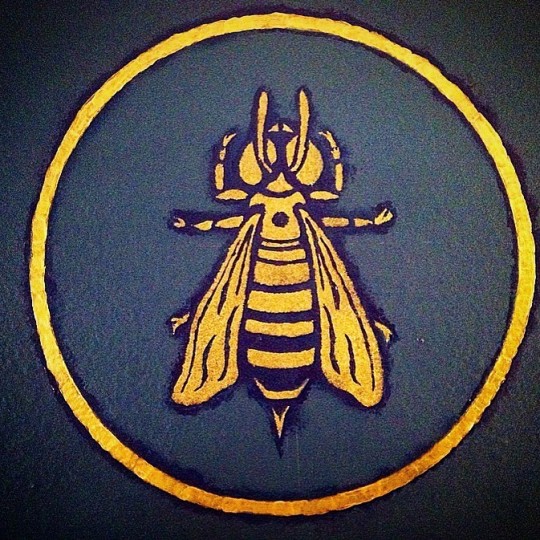
Bee, Acrylic on Wall, 2018. #bee #beehive #entomology #insects #lifeoneearth #beeaware #beeawareness #colonycollapse #colonycollapsedisorder #napoleonicbee #beemotif #decoration #inkonpaper #ink #painting #pintura #peinture #malerei #muralpainting #mural #wallart #decor #decrativeart #stencil #illustration #graphics #graphicarts #art (at Cleveland Heights, Ohio) https://www.instagram.com/p/B7Lsml_JUE9/?igshid=z844qeptdb36
#bee#beehive#entomology#insects#lifeoneearth#beeaware#beeawareness#colonycollapse#colonycollapsedisorder#napoleonicbee#beemotif#decoration#inkonpaper#ink#painting#pintura#peinture#malerei#muralpainting#mural#wallart#decor#decrativeart#stencil#illustration#graphics#graphicarts#art
0 notes
Text
positive news:
I am now official CFO of a bee club lol. Any ideas on how I can get started fundraising?
6 notes
·
View notes
Photo


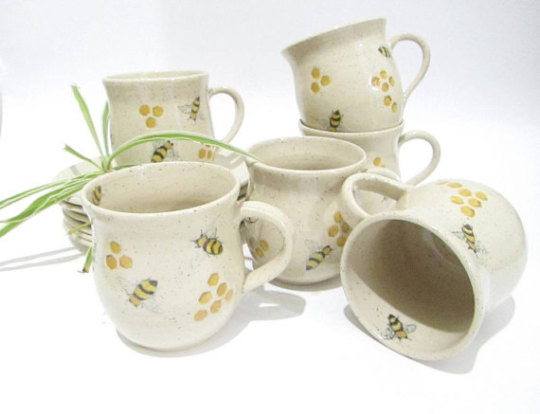
Looking after the bees. Restocking my shop with this popular design. Handmade / handpainted ceramic cups, mugs, plates and so much more
https://goo.gl/K9dmEI
Custom orders welcomed
5 notes
·
View notes
Photo

Totally forgot to post this, but here's my current Mani XD (Did it for Mother's Day in honor of my mom, a beekeeper!) Bee-You set on its own, and what better way to show them off than with my Beeautiful Hand Creme from Perfectly Posh! LOL I also made sure to have matching socks since I didn't feel like doing a pedi at the time ROFL . . . #beeyou #colorstreetnails #colorstreetnailstrips #colorstreet #beeyoucolorstreet #mothersdaynails #springnails #matchingsocks #beesocks #beenails #buzzoff #beeutifulhandcreme #beehandcream #beeutifulhandcream #bees #savethebees #beeawareness #protectthehoneybees #protecthoneybees #honeybees #beekeeper #beekeepersdaughter #daughterofbeekeepers #honeyhandcreme #honeyhandcream #honeyproducts #honey (at Courtdale, Pennsylvania) https://www.instagram.com/p/CO8dOkenb9L/?igshid=1xzzk6ee4uu85
#beeyou#colorstreetnails#colorstreetnailstrips#colorstreet#beeyoucolorstreet#mothersdaynails#springnails#matchingsocks#beesocks#beenails#buzzoff#beeutifulhandcreme#beehandcream#beeutifulhandcream#bees#savethebees#beeawareness#protectthehoneybees#protecthoneybees#honeybees#beekeeper#beekeepersdaughter#daughterofbeekeepers#honeyhandcreme#honeyhandcream#honeyproducts#honey
0 notes
Photo
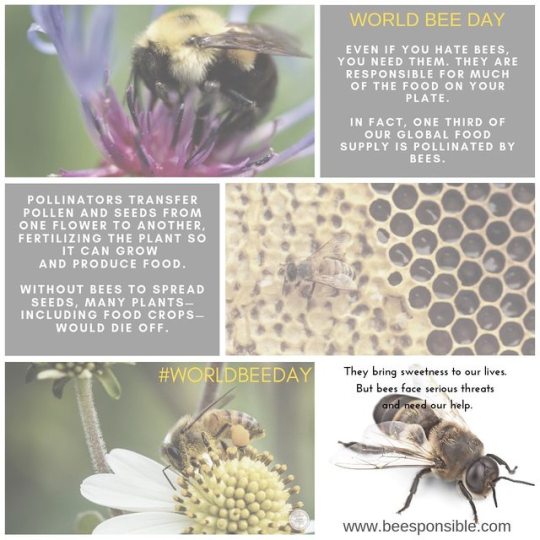
World Bee Day is celebrated on May 20 each year. The purpose of the international day is to acknowledge the role of bees and other pollinators for the ecosystem. Their sting has some benefits A toxin in bee venom called melittin may prevent HIV. Melittin can kill HIV by poking holes into the virus's protective envelope. (Meanwhile, when mellitin hitches a ride on certain nanoparticles, it will just bounce off normal cells and leave them unharmed.) Scientists at Washington University in St. Louis hope the toxin can be used in preventative gels. Bee stings may also ease pain caused by rheumatoid arthritis. Researchers at the University of Sao Paulo found that molecules in bee venom increase your body’s level of glucocorticoid, an anti-inflammatory hormone. They work harder than you During chillier seasons, worker bees can live for nine months. But in the summer, they rarely last longer than six weeks—they literally work themselves to death. They’re job creators Americans consume about 285 million pounds of honey each year. On top of that, the U.S. Department of Agriculture estimates that honeybees pollinate 80 percent of the country’s insect crops—meaning bees pollinate over $20 billion worth of crops each year #worldbeeday #worldbeeday2019 #worldbeeday🐝 #beeday #beeawareness #honey #pollinators #pathhc #healthbenefits https://www.instagram.com/p/Bxry-DrBDuG/?igshid=1hl1onylcsnr6
#worldbeeday#worldbeeday2019#worldbeeday🐝#beeday#beeawareness#honey#pollinators#pathhc#healthbenefits
0 notes
Photo

I went on a pets hike today with the Cubs & scouts and dressed up to #savethebees as any good #beagle would do! 🐝 #theabkmag #beeawareness #bees (at Toowoomba, Queensland) https://www.instagram.com/p/BxlyU7lH6ZH/?igshid=11z4d3z5fvey2
0 notes
Photo

SAVE THE BEES🐝 . . . Buzz buzz this just in Queen Bee is the bee’s knees, telling YOU to be informed and raise awareness of the busy bees!!🐝🐝 Soon they’ll be extinct just like beeswax and dinosaurs! Please help SAVE THE BEES!!!🐝 Not only honey will be gone but the environment will suffer!🐝🍯 #savethebees #queenbee #miraculousladybug #fanart #helpthebees #beeawareness #yellow #miraculous #honey Programs used: ibisPaint [image description: Queen Bee holding a sunflower in her right hand and her kwami Pollen in her left, while bees are all around Queen Bee. The background is honeycomb and ‘SAVE THE BEES’ is near the bottom.] https://www.instagram.com/p/BtDUrwBhIxE/?utm_source=ig_tumblr_share&igshid=1jhuir2rrvfgm
0 notes
Video
Like kids cooped up in the house on a rainy day, these bees in the #BeeAware beehives could hardly wait to buzz around and run off some of the energy they had stored up. They were playful and spry, a strong indication that an early spring is on its way. Like the bees, we are also hoping that the warm weather – 68 in February! – is here to stay. After the polar vortex ambled on by, the bees seemed like they never wanted to go back inside again – until it was time take care of the new spring bees getting ready to hatch out! (at Williams Honey Farm) https://www.instagram.com/p/BtybyxvHlVj/?utm_source=ig_tumblr_share&igshid=1hx1yih7huktw
0 notes
Photo
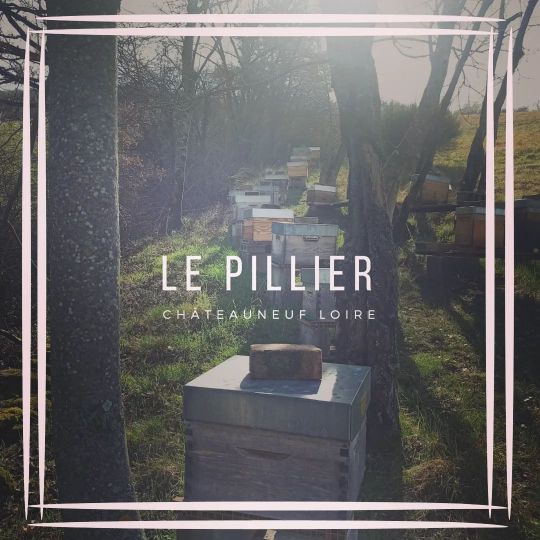
☀️ Une belle journée au rucher ! ☀️ Aujourd'hui, j'ai eu la chance de passer un après-midi ensoleillé au rucher et de voir nos abeilles à l'œuvre. C'est merveilleux de voir comment ces petites créatures travaillent dur pour collecter du nectar et du pollen, contribuant ainsi à la pollinisation de nombreuses cultures alimentaires. Je suis tellement reconnaissant de pouvoir observer ces merveilleuses abeilles dans leur habitat naturel. C'est incroyable de voir à quel point elles sont importantes pour notre environnement et notre sécurité alimentaire. Je veux encourager tout le monde à soutenir les efforts de conservation de la nature et les apiculteurs locaux en achetant du miel local et en faisant attention à nos choix alimentaires. Chacun de nous peut faire une différence pour aider les abeilles à prospérer ! Merci à toutes les abeilles pour leur travail acharné et pour leur contribution essentielle à notre monde. 🐝🌼 ► www.mon-abeille.fr #abeilles #rucher #apiculture #nature #environnement #conservation #miellocal #dimancheensoleillé #biodiversité #pollinisation #sécuritéalimentaire #merveillesdelanature #pollinisateurs #jardinage #pruniersauvage #fruit #fleurs #écologie #RespectDeLaNature #Insectes #ProtectionDesAbeilles #SauvonsLesAbeilles #AgricultureDurable #AbeilleDomestique #SustainableFarming #Cleanliness #BeesofInstagram #BeeLovers #BeeAware #BeeFriendly (à Rucher du Pillier) https://www.instagram.com/p/CpsUh20oIeI/?igshid=NGJjMDIxMWI=
#abeilles#rucher#apiculture#nature#environnement#conservation#miellocal#dimancheensoleillé#biodiversité#pollinisation#sécuritéalimentaire#merveillesdelanature#pollinisateurs#jardinage#pruniersauvage#fruit#fleurs#écologie#respectdelanature#insectes#protectiondesabeilles#sauvonslesabeilles#agriculturedurable#abeilledomestique#sustainablefarming#cleanliness#beesofinstagram#beelovers#beeaware#beefriendly
1 note
·
View note
Text
Bee Aware - Essay on Honey Bees
I wrote this essay about honey bees, and what is happening to them, as a part of my Girl Scouts Gold Award. Writing is my original work, with added quotes and information from cited sources.
Olivia Strittmatter
Mr. Holloway
DE English
6 April 2018
Bee Aware
The honey bees are dying. Between April 2016, and April 2017, beekeepers lost an average of 33% of their honey bee colonies (University of Maryland). In the past decades the honey bee population has been declining due to causes such as pesticides, diseases and climate change. Without the honey bees the environment will suffer; every aspect of life will be damaged if the Earth loses its top pollinator. There are many ways that honey bees can be helped, and there are many hazardous chemicals and altering practices, in order to help the bees regain their numbers. Honey bees are one of the most important factors in the environment, and without them the ecology of the Earth would be impacted in such a way that would harm every living thing. Honey bees are vital for all life - they pollinate a vast majority of both wild plants as well as most commercial crops; now they are dying at alarming rates; luckily there are things that everyone can do in order to help save them, such as reducing the use of pesticides, and planting bee-friendly plants.
Honey bees are one of the most important animals in the entire world. They pollinate most of our plants, especially crops that are grown, and eaten, worldwide. Bees pollinate a vast majority of the crops that people eat worldwide; a few of these foods include: apples, avocados, oranges, almonds, broccoli, and carrots. Without the honey bees mankind would lose around 70 of the 100 crops that feed 90% of the world (Sass).
Honey bee colonies are very important to commercial agriculture. Approximately half of the honey bees in the United States are used in California to pollinate the almond crop, which produces over $2.3 billion annually (Fox News). Honey bees and blueberry farmers also have a symbiotic relationship, this means that they both benefit each other. By working together the blueberry farmers get their crops pollinated, and the beekeepers get paid per hive, per week, and the bees can produce blueberry honey. Without commercial beekeepers, agricultural facilities could predict a 50% decrease in their crops produced (Weber).
Bees are shipped into agricultural areas from all over the United States in order to pollinate the crops being grown. The colonies are rented out by mass-producing agricultural facilities, and are moved from farm to farm. One month the hives could be pollinating almonds, and the next month they could be pollinating apple trees. When honey bee colonies are packaged and shipped, they will lose over 10% of the colony in the process. Overall, the transportation of honey bee colonies is harmful to the individual colonies, but it is beneficial to the crops, farms, and the economy. Do the benefits of colony rental for commercial pollination outweigh the negative impact on the hives?
Bees keep the economy buzzing. The crops pollinated by the bees produce over $30 billion in revenue each year (Woody). The honey they produce also earns over $150 million each year (Fox News). Honey bee hives are expensive to own and maintain, but, according to Sokanu, people who professionally pollinate commercial agricultural facilities - earn between $33,840 and $119,530 every year. They also produce honey, but that market is not as big as the pollination market. Keeping honey bees in areas with certain crops, such as blueberries, will produce honey that will have a different flavor than honey produced in an area that grows apples. Every year honey bees produce over 161.8 million pounds of raw honey, which is valued to be over $7 million (Bee Spotter). This is all beneficial to the economy, because it boosts it, allows for more money to be circulating, and for more money to be earned and spent.
Crops that do not need to be pollinated by bees include: corn, wheat, soybeans, rice, bananas, and plantains. Corn, rice, and soybeans are very prominent in many cultures across the world, and if the honey bees go extinct mankind would still have access to those, but they alone would not be able to sustain the world, with the global population soaring to over 7.6 billion people. Bananas and plantains don’t need any pollination, because they grow from bulbs, or rhizomes, so those would also still be important, but again, they alone cannot sustain the world’s population.
“Domesticated” honey bees are not the only crop pollinator though, lots of “native” bees live in and around agricultural areas. Many small-scale farmers rely on these native bees to pollinate their plants. Native bees also fertilise a majority of native plants, as well as neighborhood, and backyard gardens. These native bees are not affected by Colony Collapse Disorder the way that managed honey bee colonies are.
Honey bees also pollinate many wild plants. They fertilize over 90% of native, wild plants (Sass). Without the bees these plants would not be able to reproduce and spread their seeds, and a majority of them would eventually die off. Native plants dying off would negatively impact the environment by reducing the amount of water that can be absorbed into the ground, which can leave to more frequent and severe floods.
Humans benefit from honey bees because, to start, without them there would be no natural honey, no bee pollen, and no beeswax. Also without honey bees humanity would lose the native plants, which 90% of are pollinated by honey bees (Sass). The honey bees pollinate so many of the crops that humans eat, that if the honey bees go extinct it could be expected to lose 70 of the top 100 crops that feed 90% of the world (Sass). Everything that honey bees give to the world, and to people, are a major part of the economy as well, bringing in millions of dollars to all parts of the economy.
The honey bees are dying off at alarmingly fast rates. In the past decade beekeepers have seen over a 30% decrease in their colonies annually (Grossman). The top killers of honey bee colonies are Colony Collapse Disorder, American Foulbrood, European Foulbrood, and pests such as varroa mites. Even relatively smaller problems are still making big impacts, such as inexperienced beekeepers, and bee nucs and packages that are poor in quality.
Pesticides are a major killer of honey bees, especially systemic pesticides. Systemic pesticides are poisons that are coated on seeds, and are intended to kill soil-dwelling insects such as grubs, worms, and mole crickets. These pesticides then grow into the plants, and can be passed up the food chain, and into creatures such as the honeybees. The pesticides are intended to kill pests that will eat and/or harm the crops, but they end up harming animals who are beneficial to the crop and the environment. This is why honey bees are so impacted by it; because the poison is part of the plant by the time it is ready for the bees. Pesticides can also be linked to disorders such as Colony Collapse Disorder, American Foulbrood, and European Foulbrood.
CCD, more commonly known as Colony Collapse Disorder, is a phenomenon where a majority of worker bees disappear and leave behind a queen, food, and a few nurse bees. This usually happens over the winter, and no dead bees are found inside the hive; they’re just gone. Over the last few years though beekeepers have seen a slight decline in the colony deaths due to CCD. Over the past few decades the average hive loss due to CCD was at 28.7%, and recently that percentage has dropped to 23.1%. Causes for CCD can include Israeli Acute Paralysis Virus, Nosema Apis, varroa mites, pesticides, stress, inadequate environment, poor nutrition, and bad management practices.
Israeli Acute Paralysis Virus, also known as IAPV, is a virus that spreads genetically through the 9487 nt RNA. These are defective RNA genomes of the virus that are recombining into hairpins and stem-loop structures. As far as current studies have shown, this virus only affects honey bees.
Nosema Apis is a form of microsporidian, which are small, unicellular parasites. These parasites are two types of fungus, that have only been found to infect honey bees. The two fungus types are Nosema apis (N. apis), and Nosema ceranae (N. ceranae). N. ceranae appears to be more dangerous to honey bees than N. apis, because it attacks the cells in the bees’ guts and kills them faster. Bees that are affected could have trouble digesting food for their entire lives, and they cannot produce royal jelly from their hypopharyngeal glands. Queens who are affected by this parasite do not lay eggs, and will have a much shorter lifespan.
Varroa mites are external parasites that attack both the adult honey bees, and the brood - the honey bee larva. They drink the blood of the adults and the brood, especially drone brood; this will cause a shorter bee lifespan, and newly hatched brood may emerge with deformities, such as missing legs and/or missing wings. Varroa mite infestations can be treated relatively easily if caught early enough. One way to treat them is by applying vaporized oxalic acid once a week for three weeks, this will significantly lower the amount of mites in the hive. Another way for treating small infestations is to dump powdered sugar into the beehive, and allowing the bees to clean the sugar, and mites, off of each other.
American Foulbrood, also known as AFB, is a bacterial disease of the bee brood. This fatal, spore-forming bacteria only infects the honey bee larvae, and typically kills it in the pre-pupal stage. This infection can, and will eventually, kill the entire hive because it kills a majority of the brood, leaving less and less adult honey bees until there are none left. It is not a highly contagious disease but the spores can transfer between hives through beekeeper practices, such as sharing equipment between hives. Adult honey bees will not contract AFB, but they can spread it to other hives through natural processes such as hive robbing. AFB is incurable, and the only way to end the spread is to destroy the colony as well as the hive they were living in, because the spores can remain viable for over 50 years (Bee Aware).
European Foulbrood, or EFB, is a bacterial disease that impacts the bee brood. It can be caused by an increase in stress on the colony, such as changing weather, malnutrition, or movement of the hive. The EFB infection begins when the larvae ingest Melissococcus plutonius, the bacteria; it is ingested from contaminated nurse bees, who were contaminated by removing dead brood. These nurse bees then feed the larvae and spreading the contaminant. The infecting bacteria competes with the larvae for the ingested brood food, and will eventually starve it to death. Symptoms tend to be noticed in Spring, and can be noticed because there are many more foraging bees than nurse bees, and the larvae aren’t being fed as much as they need to be, so they starve to death. The infected larvae will turn into a semi-fluid state, and will change from pearly white, to yellow and brown. EFB is highly contagious and will remain viable for many years in honey, wax, and on beekeeper equipment; it will also be transmitted to other colonies through hive robbing. (Bee Aware and Bee Informed).
Certain pesticides cause more damage to the honey bee population than others. Neonicotinoids are one of the most commonly used pesticides in agricultural facilities, and have been linked to honey bee deaths. In recent studies it has been proven that neonicotinoids do not outright kill the bee colonies, but instead it requires long term exposure to the chemical in order to kill. The chemicals impact the queen bee especially, which can cause a decrease in egg laying, and eventually wipe out the hive (Dengler). Another dangerous pesticide, Imidacloprid, was declared by the EPA to affect bees. The study showed that if the “imidacloprid at levels above 25 parts per billion - a common level for neonics in farm fields - they suffer harm.” (Philpott). Since then the EPA has restricted and limited the use of imidacloprid. A third bee-killing pesticide that could potentially be allowed to be used is thiamethoxam. It recently was considered by the EPA to be sprayed on 165 million acres of US farmland. This pesticide damages a honey bee’s homing abilities and impairs flight. Simone Tosi, Giovanni Burgio, and James C. Nieh performed an experiment in which it was proved that these results “provide the first demonstration that acute or chronic exposure to a neonicotinoid alone can significantly alter bee flight. Such exposure may impair foraging and homing, which are vital to normal colony function and ecosystem services.” (Tosi, Burgio, and Nieh).
Climate change is also a big factor in the decrease in the global honey bee population. As mentioned earlier, climate change can bring stress to bee colonies, which can lead to disorders and diseases, and harm the hives. It has been shown that in Poland, the honey bees are “responding to changes in climate by advancing the date of their first winter flight - the wakening moment after winter... is attributed to increasing temperatures” (Greenpeace Research Laboratories 27). The changes in the climate will impact how the bees interact with the sources they pollinate. According to the Greenpeace Research Laboratories, “Recent analysis has suggested that between 17% and 50% of pollinator species will suffer from food shortages” because of the alteration of time periods where flowering plants are blooming. These scientists have predicted that these alterations may cause the extinction of some pollinating species, such as honey bees, and some flowering plants that they pollinate. They also conclude that climate change “may also lead to “the large-scale extinction of interactions which are responsible for a key ecosystem service, that of the pollination of plants”” (Greenpeace Research Laboratories 27).
Honey bees possess enough genetic variability to potentially survive minor climate changes, it is not know how they will be impacted in the long run. It is shown that their genetic makeup, as well as the information known about how they deal with diseases, and their behavior that they have the possibility of evolving to live in a variety of climates, even as they change over time. The world cannot lose the genetic variety of the honey bee though, and must take precautionary measures to preserve and protect that, or there is a good chance that the bees will die-off because of one disease or one giant ecological change/disaster.
Another reason why the honey bees are dying, and spreading diseases rapidly, is because of unexperienced beekeepers. Inexperienced beekeepers tend to have “double the winter mortality rate when compared to professional beekeepers” (Jacques). Jacques’ study also showed that professional beekeepers had minimal signs of disease and pests, while inexperienced and/or hobbyist beekeepers had heavy signs of varroa infestation, and bacterial infection. A pan-European epidemiological study showed that the best way to combat die-offs from unexperienced beekeeper colonies is to educate the “newbees” and promote disease control (PLOS).
Nucleus colonies, otherwise known as nucs, are small bee hives that come with 4-5 frames of preexisting honeycomb, honey, brood, and a functioning queen with workers and drones. These are prefered to start off with, because they already have a base set up, and can continue building and growing once set up in a real hive. Packaged bees are another option for beginning hives. These bees come in a wooden box with around 3,000-10,000 honey bees - workers and drones - inside, and a queen (The Honey Company). These bees have no basis and must build all of their comb from nothing; this makes it harder for them to start out, and they have a higher chance of failure. With the increase in popularity of hobby beekeeping, honey bee nucs and packages are needing to be produced at a much higher rate than they should be. This causes the nucs and packages to be lower in quality, and risk the rapid spread of disease and parasites all over the country.
Individuals can help save the honey bees though, through numerous, and easy, changes. The biggest change that a person can do, is to educate themselves and others on how much the honey bees do for us, and how much humanity relies on their services. Reading books, research papers, scientific journals, and news articles on honey bees is a great way to expand your knowledge. Education does not just include the general public, education includes educating novice beekeepers, agricultural companies, and the governmental authorities. Public education can range from teachers giving brief presentations on honey bees and what is happening, to larger-scale events such as nationwide movements on the honey bee epidemic. An easy way to educate yourself and the community is by spreading the knowledge that honey bees are not out to sting people. Bees are vegetarians, so they do not chase after people, because they have no interest in people, unless they are protecting their hive. When honey bees sting someone their stinger is pulled out, and it pulls out a majority of their internal organs with it.
Local beekeepers can mentor people interested in beekeeping, so that they can gain the knowledge they need before they buy their own honey bee colony. Educating beginning beekeepers can reduce the amount of colonies that die due to inexperience, and lack of knowledge. For more experienced beekeepers they can look into local classes on how to use sustainable practices with their colonies. Some sustainable practices include: producing numerous other nucleus hives, catching swarming colonies, and reducing use of bee-medications and chemical treatments (Connor).
Quitting use of chemicals and pesticides in personal gardens, and on lawns can be a big step to helping the honey bees regain their footing. Some examples of these harmful pesticides include clothianidin, aldicarb, and carbaryl (Stokstad). Toxic pesticides can be replaced by natural pesticides like vinegar, chrysanthemums, pepper, garlic, onion, and essential oils (Kusby). These replacements are safe for the environment, and are bee-friendly; this means that they will not harm the honey bees, or damage the ecosystem.
A third easy way to help the honey bees is to plant bee-friendly plants in personal, and/or community gardens. Bee-friendly plants are plants that flower for relatively long periods of time, produce a lot of flowers, and produce a large amount of nectar. Some examples of these types of plants include lavender, white clover, california lilac, heather, bell flower, sage, and many more (Bee Friendly). Another way to plant bee-friendly plants is by planting a Bee Garden. Bee Gardens can create many more areas for honey bees to flock to in order to collect nectar and pollen.
Large-scale and small-scale corporations and companies alike can also help to save the honey bees. A big way to reduce the massive die-off is by reducing the amount of CO2 that is being released into the atmosphere. Increased amounts of CO2 in the atmosphere is a major contributor to Global Climate Change, and in turn, is leading to the increase of cases of Colony Collapse Disorder.
Another way that corporations and companies can help save the honey bees is by reducing environmental depletion. Large companies, such as construction companies that build developments, destroy huge amounts of forests and other natural lands in order to expand cities and the suburbs. By destroying these areas, the honey bees are being forced to move into cities and suburbs, and this greatly reduces the food available to the honey bees. Also, cities and neighborhoods that are more densely populated usually means that there are more chemicals in the area, and these chemicals can contribute to Colony Collapse Disorder.
Large companies and corporations can also spread knowledge and information about honey bees. In 2014 Honey Nut Cheerios and Burt’s Bees joined together and started a movement called Bring Back the Bees. In this Honey Nut Cheerios took Buzz, their honey bee mascot, off of the front of their box, and instead replaced it with a white outline in the shape of Buzz with the words “Bring Back the Bees” near him. In boxed labeled like this there was a free packet of bee-friendly seeds for the buyer to plant. In 2014 they claim to have given out 1.5 billion wildflower seeds to consumers (Cheerios). In this movement, Burt’s Bees, a cosmetics company, claims to have planted over 5,000 wildflower seeds for every special edition of lip balm for the Bring Back The Bees annual campaign (Burt’s Bees).
The government can help by passing more legislation banning and restricting the use of harmful pesticides and fertilizers. Certain pesticides and fertilizers are especially toxic to honey bees; examples of harmful pesticides that are commonly used are clothianidin, aldicarb, and carbaryl (Stokstad). A major pesticide that is used by large-scale agricultural corporation are neonicotinoids, and if the United States government could severely restrict use of these, the overwinter deaths of honey bee colonies would reduce within years.
In countries where the government has banned neonicotinoids, such as Germany, the rates of bee diseases are less prevalent than countries that still allow neonicotinoids (Morelle). While there is scientific proof that neonicotinoids are harmful to honey bees, some countries, such as the United States, are approving of the use of these toxic chemicals. The United States government has approved of the use of neonicotinoids on the grounds that “the Environmental Protection Agency (EPA) had relied on “flawed and limited” data, and its green light was unjustified given the “precariousness of bee populations”” (Pearce). The European Commission has recently done a large-scale experiment on 2,000 hectares across European countries to test the impact of neonicotinoids. The study showed the seeds covered in neonicotinoids had many negative effects on managed honey bees as well as on wild honey bees, and that neonicotinoids could be a major contributor to Colony Collapse Disorder (Morelle).
The United States government could do much more to minimize the nation’s participation in Global Climate Change. The USA is the only country in the world that is not a part of the Paris Agreement, which is a global organization that is working together to battle global climate change. If every single country was working together than it would be easier to work together to find a way to save the Earth, and in turn, to save the honey bees. Climate-related disadvantages for pollinators would include food shortages, and a decrease in overall honey bee populations.
In the past few decade honey bees have been dying off at alarming rates. These massive die-offs are caused by all sorts of factors, some include: Colony Collapse Disorder, American Foulbrood, European Foulbrood, parasites, pesticides, and climate change. People all over the world need to take action to save these hard-working creatures, and in turn, save the world. The honey bees do so much more for humans besides provide honey, and if the honey bees are lost, many agricultural crops will also be severely affected. Without the honey bees over one-third of crops would go unpollinated, and would not be able to produce food. In order to save the honey bees individuals, corporations, and governments alike much work together to protect and preserve this 90-million year old species or risk losing human lives as well.
Bibliography
“#Bring Back the Bees Is Back!” Cheerios, www.cheerios.com/BringBackTheBees.
“10 Crops That Would Disappear without Bees.” Fox News, FOX News Network, www.foxnews.com/food-drink/2012/07/19/10-crops-that-would-disappear-without-bees.htm.
“25 Plants For Bees In Your Garden.” Bee Friendly, beefriendly.ca/25-plants-for-bees-in-your-garden/.
“A Home Gardener's Guide To Safe, Bee-Friendly Pesticides.” Garden Collage Magazine, 19 Sept. 2017, gardencollage.com/wander/gardens-parks/home-gardeners-guide-safe-bee-friendly-pesticides/.
“American Foulbrood.” Bee Aware, beeaware.org.au/archive-pest/american-foulbrood/#ad-image-0.
“Beekeeper.” Sokanu, www.sokanu.com/careers/beekeeper/salary/.
Bees in Decline. Greenpeace Research Laboratories Technical Report , Jan. 2013, sos-bees.org/wp-content/uploads/2014/04/BeesInDecline.pdf.
“Bees Win as US Court Rules against Neonicotinoid Pesticide.” New Scientist, www.newscientist.com/article/dn28167-bees-win-as-us-court-rules-against-neonicotinoid-pesticide/.
“Colony Collapse Disorder.” EPA, Environmental Protection Agency, 1 Mar. 2018, www.epa.gov/pollinator-protection/colony-collapse-disorder.
“Comparing Mite Treatments.” Bee Culture, 22 Aug. 2016, www.beeculture.com/comparing-mite-treatments/.
“Declining Bee Populations Pose a Threat to Global Agriculture.” Yale E360, e360.yale.edu/features/declining_bee_populations_pose_a_threat_to_global_agriculture.
Dengler, Roni. “Neonicotinoid Pesticides Are Slowly Killing Bees.” PBS, Public Broadcasting Service, 29 June 2017, www.pbs.org/newshour/science/neonicotinoid-pesticides-slowly-killing-bees.
“EPA to Consider Approving Spraying of Bee-Killing Pesticide on 165 Million Acres of U.S. Farmland.” Center for Biological Diversity, www.biologicaldiversity.org/news/press_releases/2017/pesticides-12-19-2017.php.
“European Foulbrood (EFB).” Bee Informed Partnership, beeinformed.org/2013/12/13/european-foulbrood-efb/.
“Inexperienced Hobbyist Beekeepers 'Major Driver' of Honey Bee Colony Losses in Europe.” Genetic Literacy Project, 12 Jan. 2018, geneticliteracyproject.org/2017/04/07/inexperienced-hobbyist-beekeepers-major-driver-honey-bee-colony-losses-europe/.
Jacques, Antoine, et al. “A Pan-European Epidemiological Study Reveals Honey Bee Colony Survival Depends on Beekeeper Education and Disease Control.” PLOS ONE, Public Library of Science, journals.plos.org/plosone/article?id=10.1371/journal.pone.0172591.
Le, Y, and M Navajas. “Climate Change: Impact on Honey Bee Populations and Diseases.” Revue Scientifique Et Technique (International Office of Epizootics)., U.S. National Library of Medicine, Aug. 2008, www.ncbi.nlm.nih.gov/pubmed/18819674.
Maori, E, et al. “Isolation and Characterization of Israeli Acute Paralysis Virus, a Dicistrovirus Affecting Honeybees in Israel: Evidence for Diversity Due to Intra- and Inter-Species Recombination.” The Journal of General Virology., U.S. National Library of Medicine, Dec. 2007, www.ncbi.nlm.nih.gov/pubmed/18024913.
Maori, Eyal, et al. “Isolation and Characterization of Israeli Acute Paralysis Virus, a Dicistrovirus Affecting Honeybees in Israel: Evidence for Diversity Due to Intra- and Inter-Species Recombination.” Journal of General Virology, Microbiology Society, 1 Dec. 2007, jgv.microbiologyresearch.org/content/journal/jgv/10.1099/vir.0.83284-0.
Morelle, Rebecca. “Large-Scale Study 'Shows Neonic Pesticides Harm Bees'.” BBC News, BBC, 29 June 2017, www.bbc.com/news/science-environment-40382086.
Philpott, Tom. “The EPA Finally Admitted That the World's Most Popular Pesticide Kills Bees-20 Years Too Late.” Mother Jones, 23 June 2017, www.motherjones.com/food/2016/01/epa-finds-major-pesticide-toxic-bees/.
“Plant a Bee Garden -.” The Honeybee Conservancy, thehoneybeeconservancy.org/plant-a-bee-garden/.
Sass, Jennifer. “Why We Need Bees: Nature's Tiny Workers Put Food on Our Tables.” Bee Facts, Mar. 2011, www.nrdc.org/sites/default/files/bees.pdf.
“Should I Get a 2- or 3-Pound Package?” The Honey Company, thehoneycompany.com/should-i-get-a-2-or-3-pound-package/.
StokstadJun, Erik, et al. “Controversial Pesticides Can Decimate Honey Bees, Large Study Finds.” Science | AAAS, 8 Dec. 2017, www.sciencemag.org/news/2017/06/controversial-pesticides-can-decimate-honey-bees-large-study-finds.
“Sustainability In Beekeeping.” American Bee Journal, 10 Dec. 2015, americanbeejournal.com/sustainability-in-beekeeping/.
“Ten Things You Can Do to Help Bees.” Queen of the Sun What Are the Bees Telling Us RSS, www.queenofthesun.com/get-involved/10-things-you-can-do-to-help-bees/.
“The Economic Importance of Bees.” The Economic Importance of Bee$, BeeSpotter, University of Illinois, beespotter.org/topics/economics/.
“The Importance of Bees: Commercial Beekeeping.” Monsanto, monsanto.com/company/sustainability/biodiversity/articles/importance-bees-commercial-farming/.
Tosi, Simone, et al. “A Common Neonicotinoid Pesticide, Thiamethoxam, Impairs Honey Bee Flight Ability.” Nature News, Nature Publishing Group, 26 Apr. 2017, www.nature.com/articles/s41598-017-01361-8.
“Frequently Asked Questions” Burt's Bees., www.burtsbees.com/content/bring-back-the-bees-faq/faqs-bbtb.html.
“US Beekeepers Lost 33 Percent of Bees in 2016-17.” Phys.org - News and Articles on Science and Technology, phys.org/news/2017-05-survey-honeybee-losses-horrible-bad.html.
“Varroa Mites Infesting Honey Bee Colonies.” Varroa Mites Infesting Honey Bee Colonies | Entomology, entomology.ca.uky.edu/ef608.
Woody, Todd. “Scientists Discover What's Killing the Bees and It's Worse than You Thought.” Quartz, Quartz, 3 Mar. 2014, qz.com/107970/scientists-discover-whats-killing-the-bees-and-its-worse-than-you-thought/.
#honeybees#bees#beeaware#goldaward#girl scouts#girlscouts#gold award#honey bees#girl scouts gold award#girlscoutsgoldaward#environment#savethebees#save the bees
0 notes
Photo
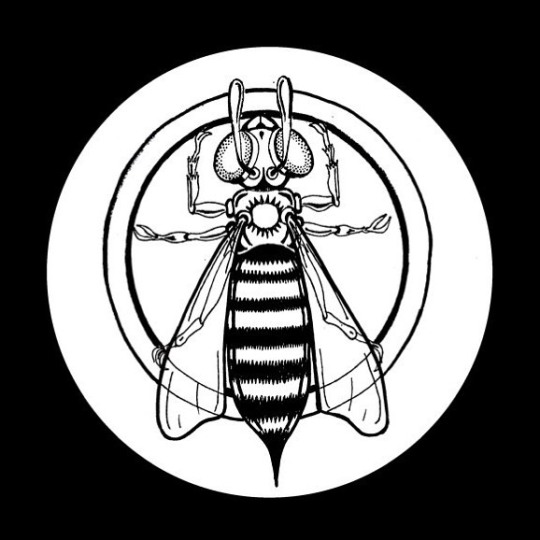
Bee, Ink on Paper, 2018. #bee #beehive #entomology #insects #lifeoneearth #beeaware #beeawareness #colonycollapse #colonycollapsedisorder #napoleonicbee #beemotif #decoration #inkonpaper #ink #drawing #illustration #graphics #graphicarts #art (at Cleveland Heights, Ohio) https://www.instagram.com/p/B7LsPJnJQUc/?igshid=1d7n2skaf12xy
#bee#beehive#entomology#insects#lifeoneearth#beeaware#beeawareness#colonycollapse#colonycollapsedisorder#napoleonicbee#beemotif#decoration#inkonpaper#ink#drawing#illustration#graphics#graphicarts#art
0 notes
Text
Spring Break Plans? Florida Bees Want To Say Hi!
In tribute to the spring break mindset that the first few weeks of March brings about, let’s talk about an issue Florida runs into with its honey bee population.
Florida has honey bees, but they also have Africanized Honey Bees. The Florida Department of Agriculture and Consumer Services explains the situation Floridians are faced with when it comes to bees. The bee population in Florida is made up of both docile honey bees, like those the northern states have, and aggressive honey bees that came from Africa. Here is a tidbit from their website article on the matter.
“(African Honey Bees) were brought to Brazil in the 1950’s for testing as possible alternative pollinators and honey producers because of their reputation of being hardy in tropical environments. At the time, their defensive nature and ability to reproduce in greater numbers were not well understood. Some were accidentally released and have spread throughout South and Central America, Mexico and the southern U.S.” (Westervelt, 2018).
It is now understood that Africanized Honey Bees are far more aggressive and defensive than “regular” honey bees. What does this mean? Simply, it means that when you are in Florida or other southern areas on spring break, know that when you see a cute, fuzzy honey bee it could possibly want to attack you as if it were an evil, mean wasp. Be careful, watch where you walk, and know the native versus invasive species of the area you are visiting.
Florida Department of Agriculture and Consumer Services also suggests that if you are stung by a bee and think it may be an African Honey Bee to immediately seek medical attention if needed. They also suggest that when stung, run quickly away from where you are with your hands covering your face and get to safety. Suggested “safe” locations would include: a car with shut windows, a house, a mystical land far far away, or a building with closed doors and windows. From there, assess your stings and if possible call a licensed pest control company because African Honey Bees are not to be treated nicely the way “regular” honey bees are.
Westervelt, D. African Honey Bee https://www.freshfromflorida.com/Divisions-Offices/Plant-Industry/Pests-Diseases/African-Honey-Bee.
0 notes
Photo
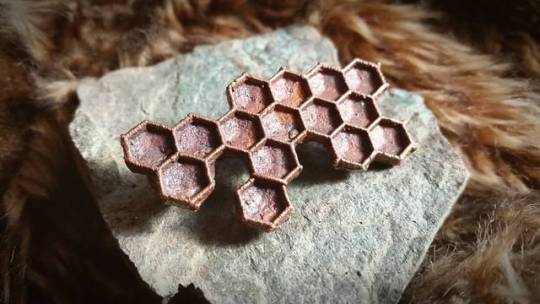
"Bee Aware" Real Honeycomb Hat Pin Honeycomb from bee hive! Eletroformed $45 shipped to your door (US) Brandon Arnold 2017 #jewelry #thirdeyejewellery.com #copperplate #electroformed #beehive #honeycomb #savethebees #beeaware #stlouisgram #stl #brandonarnoldbtp #hatpins #hatpin
#hatpins#stl#electroformed#honeycomb#stlouisgram#beeaware#hatpin#copperplate#savethebees#jewelry#beehive#brandonarnoldbtp#thirdeyejewellery
0 notes